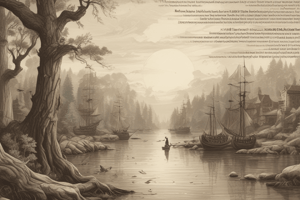Podcast
Questions and Answers
Which citation style uses a numbered format for in-text citations?
Which citation style uses a numbered format for in-text citations?
- Harvard
- APA
- MLA
- IEEE (correct)
Which citation style is most commonly associated with the social sciences?
Which citation style is most commonly associated with the social sciences?
- MLA
- APA (correct)
- IEEE
- Turabian
Which citation style is specifically tailored for legal documents?
Which citation style is specifically tailored for legal documents?
- CSE
- Bluebook (correct)
- SAA
- AMA
What is the primary purpose of a Works Cited page?
What is the primary purpose of a Works Cited page?
In which citation style would you find an emphasis on provenance and context for archival materials?
In which citation style would you find an emphasis on provenance and context for archival materials?
What distinguishes Chicago style from its simplified version Turabian?
What distinguishes Chicago style from its simplified version Turabian?
Which of the following citation systems does CSE NOT include?
Which of the following citation systems does CSE NOT include?
Which citation style is recognized for its guidelines in medical and health sciences?
Which citation style is recognized for its guidelines in medical and health sciences?
Flashcards are hidden until you start studying
Study Notes
Citation Styles
-
APA (American Psychological Association)
- Commonly used in social sciences.
- Author-date format (e.g., Smith, 2020).
- Includes a reference list at the end.
- In-text citations include the author's last name and publication year.
-
MLA (Modern Language Association)
- Widely used in humanities, especially literature and language.
- Author-page format (e.g., Smith 23).
- Works Cited page at the end of the document.
- In-text citations consist of the author's last name and page number.
-
Chicago/Turabian
- Chicago style is used in various disciplines; Turabian is a simplified version for students.
- Two systems: Notes and Bibliography (footnotes/endnotes) and Author-Date.
- Bibliography page for full references.
- In-text citations vary by system; can include footnotes or parenthetical.
-
Harvard
- Preferred in many academic fields, similar to APA.
- Author-date system (e.g., Smith 2020).
- Reference list at the end of the document.
- In-text citations consist of author's last name and year of publication.
-
IEEE (Institute of Electrical and Electronics Engineers)
- Used primarily in engineering and computer science.
- Numbered citations (e.g., [1], [2]).
- References are listed in the order of citation.
- In-text citations refer to the number assigned to the source.
-
AMA (American Medical Association)
- Commonly used in medicine and health sciences.
- Numbered citation style similar to IEEE.
- References listed in the order they appear in the text.
- In-text citations include superscript numbers.
-
CSE (Council of Science Editors)
- Used in natural and physical sciences.
- Three citation systems: Name-Year, Citation-Sequence, and Citation-Name.
- References are formatted based on the chosen system.
- In-text citations vary accordingly.
-
Bluebook
- Standard for legal documents and law journals.
- Complex citation rules and formatting.
- Based on case law, statutes, and legal principles.
- Uses abbreviations and specific formats for legal sources.
-
SAA (Society of American Archivists)
- Used for citing archival materials.
- Emphasizes the importance of provenance and context.
- Specific formats for various types of archival sources.
-
General Best Practices
- Always check for specific formatting guidelines from instructors or publishers.
- Be consistent with the chosen citation style throughout the document.
- Include all necessary information for the citation to be complete and accurate.
Citation Styles Overview
- Various citation styles are utilized across academic disciplines, each with unique rules and formats.
APA (American Psychological Association)
- Commonly used in social sciences.
- Follows an author-date format (e.g., Smith, 2020).
- Requires a reference list at the document's end.
- In-text citations feature the author's last name and publication year.
MLA (Modern Language Association)
- Widely adopted in humanities, particularly in literature and language.
- Uses an author-page format (e.g., Smith 23).
- Includes a "Works Cited" page at the document's conclusion.
- In-text citations consist of the author's last name and page number.
Chicago/Turabian
- Chicago style serves various disciplines while Turabian is a simplified version for students.
- Two main systems exist: Notes and Bibliography (footnotes/endnotes) and Author-Date.
- Accompanied by a bibliography page for full references.
- In-text citations differ by the chosen system and can include footnotes or parenthetical references.
Harvard
- Frequently preferred in several academic fields, similar to APA.
- Adopts an author-date system (e.g., Smith 2020).
- Requires a reference list at the document's conclusion.
- In-text citations incorporate the author's last name and year of publication.
IEEE (Institute of Electrical and Electronics Engineers)
- Primarily used in engineering and computer science.
- Features numbered citations (e.g., [1], [2]).
- References are organized in the order of citation.
- In-text citations refer to the number assigned to the source.
AMA (American Medical Association)
- Commonly employed in medicine and health sciences.
- Numbered citation style akin to IEEE.
- References are listed in the order they first appear in the text.
- In-text citations utilize superscript numbers.
CSE (Council of Science Editors)
- Applied in natural and physical sciences.
- Offers three citation systems: Name-Year, Citation-Sequence, and Citation-Name.
- References formatted according to the selected system.
- In-text citations vary based on the chosen citation method.
Bluebook
- Established standard for legal documents and law journals.
- Features complex citation rules and specific formatting.
- Based on case law, statutes, and legal principles.
- Uses abbreviations and distinct formats for legal references.
SAA (Society of American Archivists)
- Utilized for citing archival materials.
- Highlights the significance of provenance and context.
- Specific referencing formats are designated for various archival sources.
General Best Practices
- Always verify specific formatting guidelines from instructors or publishers.
- Maintain consistency with the selected citation style throughout the document.
- Ensure all necessary information is provided for complete and accurate citations.
Studying That Suits You
Use AI to generate personalized quizzes and flashcards to suit your learning preferences.




